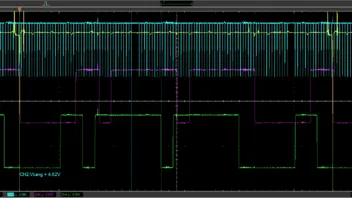Hi folks,
as an owner of a Renault Megane 3 (Model 2013, H5F400, 180.000 km) I came across the article "The Hidden Cause Behind Failing Timing Chains"
(https://www.diagnosedan.com/de/the-hidden-…-timing-chains/)
Especially the extract from DD-5955 on the crankshaft/camshaft ratio captured with the scope caught my interest.
So I replicated this capture with my H5F400 and you can see the identical 7 crankshaft pulses from the gap til the next edge of the inlet camshaft signal.
Is anyone familiar with the signals of a fresh timing chain, or does my timing chain need replacement asap ?
I sent an email to diagnosedan.com but never received an answer, they are clearly not interestest in inquiries from hobbyists.
The crankshaft seems to be divided by 60 teeth with 2 missing for the gap, so one pulse to the next one would be equivalent to 6°.
If 7 crankshaft pulses like in my picture already defines a worn out chain, how many pulses will I count for a freshly mounted timing chain ?


